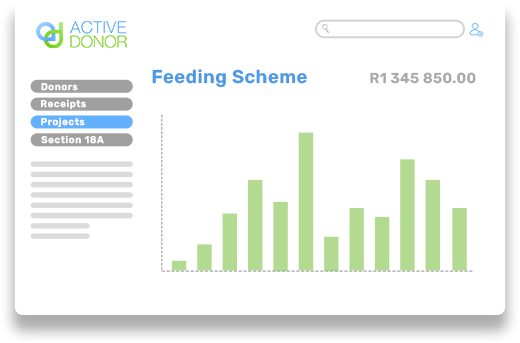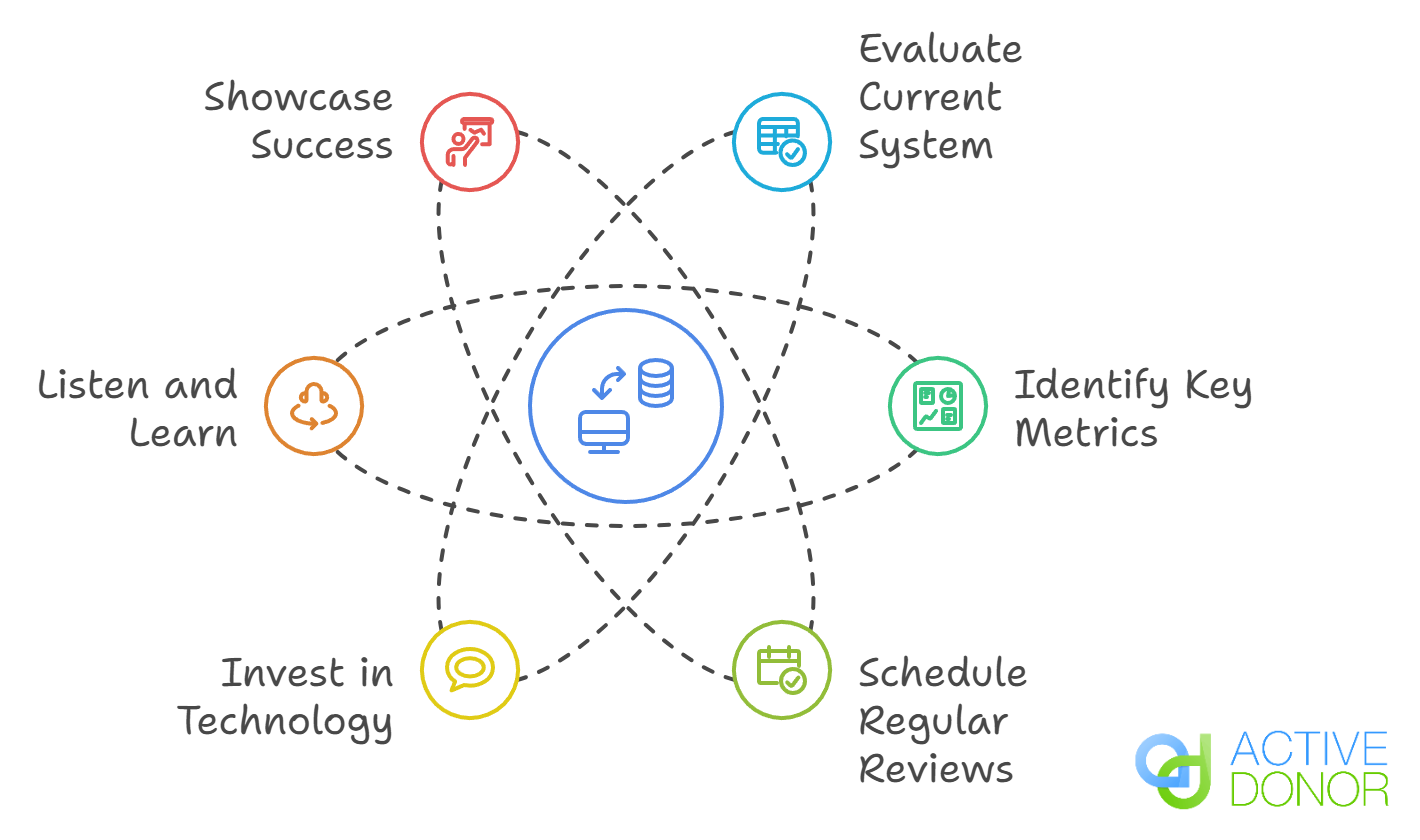
Your donor list isn’t just a collection of names and numbers, it’s your foundation for smarter, more effective fundraising. Whether you’re a small charity or a multi-national organization, managing donor data properly can be the difference between missed opportunities and a thriving fundraising campaign!
In this comprehensive guide, we’ll explore 10 power shifts that can transform your donor engagement and help you raise more. We’ll dive into both strategic insights and practical steps, highlighting how leveraging nonprofit CRM software tools can empower your NPO, while illustrating real-world examples for key engagement strategies.
Are donor management tools useful for small nonprofits?
Effective donor data management is the cornerstone of successful fundraising. A well-maintained, central donor database helps you:
- Personalize Donor Communications: Tailor your messaging to fit each donor’s giving history and preferences.
- Segment Your Audience: Identify donor groups based on demographics, donation patterns, and engagement levels.
- Track Trends: Understand donor behavior through detailed reports and analytics.
- Improve Engagement: Develop targeted campaigns that resonate with different segments.
- Increase Retention: Nurture long-term relationships with repeat donors.
For nonprofits in South Africa today, using dedicated donor management platform isn’t just an operational choice – it’s now a strategic necessity. Tools that centralize data in one place, automate your outreach, and provide actionable insights can turn raw donor information into a powerful fundraising engine.
Best Practices for Managing Your Donor Database
Below are 10 actionable strategies that will transform how you manage donor data and engage with your supporters. Each point comes with practical insights, and for several key strategies, we provide illustrative examples or best practices that show how these shifts can be implemented for your NPO.
1. Personalize Your Gratitude 🙏
- Old Approach: Sending generic thank-you messages that fail to resonate.
- New Strategy: Tailor thank-you messages based on donation size, frequency or project.
- How It Works:
- ActiveDonor Feature: A donor management software solution like ActiveDonor can automatically generate personalized messages that include details about the donor’s details and preferred projects.
- Key Benefits:
- Increases donor satisfaction
- Strengthens the emotional connection with the cause
- Encourages future giving
Personalization matters. When donors feel recognized as individuals, they’re more likely to continue supporting your cause.
2. Segment With Purpose 🔖
- Old Approach: Not segmenting your donor list, which leads to unfocused communications.
- New Strategy: Divide donors by giving patterns, demographics, and engagement levels to create targeted campaigns.
- How It Works:
- ActiveDonor Feature: ActiveDonor features flexible donor segmentation tools such as allowing you to create custom donor tags. You can then segment using criteria such as donation frequency, location, or Section 18A requirements etc.
- Key Benefits:
- Increases campaign relevance
- Optimizes resource allocation
- Enhances donor retention through tailored outreach
Effective segmentation ensures that every message reaches the right audience with the right tone, boosting both engagement and response rates.
3. Analyse With Insight 📊

- Old Approach: Ignoring donor trends and missing critical insights into behavior.
- New Strategy: Use analytics to spot trends in donor behavior and adjust your strategies accordingly.
- How It Works:
- ActiveDonor Feature: ActiveDonor’s integrated fundraising reports dashboards and detailed donor profiles allow you to monitor key metrics such as donation trends, campaign performance, and donor lifetime value.
- Key Benefits:
- Identifies growth opportunities
- Helps predict future giving patterns
- Supports data-driven decision-making
Analytical insights transform raw data into actionable strategies, ensuring that your fundraising efforts are always aligned with donor behavior.
4. Engage With Intention 💬
- Old Approach: Failing to track donor engagement, leading to missed opportunities to connect with donors.
- New Strategy: Monitor event attendance, social media interactions, and volunteerism to strengthen your donor relationships.
Illustrated Example:
Imagine a local nonprofit that organizes community events regularly. Instead of relying solely on broad email blasts, the organization starts tracking detailed engagement metrics:
- Event Attendance: They note which donors attend events consistently.
- Social Media Interactions: They monitor likes, shares, and comments on their posts.
- Volunteer Activities: They track volunteer hours and participation.
Recently, a KZN based children’s home tracked donor engagement by monitoring event attendance, social media interactions, and volunteer contributions. They identified a dedicated supporter who consistently attended events, re-shared their social media posts, and volunteered occasionally. Recognizing her commitment, the organization invited her to join the board. This decision not only strengthened governance but is now also leading to gradual increase in community-driven donations, showcasing how intentional engagement tracking can uncover passionate leaders!
This intentional tracking helps NPOs create deeper, more meaningful connections with their supporters, ultimately leading to stronger, long-term relationships.
5. Listen Actively 👂
- Old Approach: Not using donor feedback, resulting in missed opportunities for improvement.
- New Strategy: Use surveys to understand donor preferences and improve communication channels.
Illustrated Example:
Imagine a scenario where an NPO holds an annual fundraising gala. After the event, they distribute a simple survey asking attendees for feedback. The responses reveal that many donors would prefer receiving detailed reports on how their contributions are making a difference. Armed with this insight, the organization adjusts its communication strategy, incorporating periodic impact reports and personalized updates. Over time, donors report feeling more connected to the causes, and the NPO sees an increase in repeat donations and higher overall engagement with their supporters.
Listening to donor feedback allows nonprofits to fine-tune their strategies and ensure that every interaction is aligned with donor expectations.
6. Recognize Potential 💪
- Old Approach: Overlooking donor capacity, thereby missing opportunities for higher contributions.
- New Strategy: Identify high-capacity donors and offer personalized engagement opportunities.
Illustrated Example:
A Western Cape based NPO noticed a local business consistently donating to a specific welfare project. Recognizing their alignment with the cause, the NPO tailored a campaign and proposed a sponsorship initiative. They invited the business to co-design a more sustainable program, offering branding opportunities and regular impact updates. This personalized approach deepened the partnership, which is now in its second year, significantly expanding the project’s reach and impact.
By recognizing and nurturing major donors, nonprofits can cultivate more robust funding streams and create lasting partnerships.
7. Nurture Your Donor Relationships 💖
- Old Approach: Neglecting donor retention, which results in lost momentum over time.
- New Strategy: Focus on retaining repeat donors by showing appreciation and impact.
- How It Works:
- ActiveDonor Feature: ActiveDonor offers features that enable nonprofits to schedule automated acknowledgements and personalized reminders. These tools ensure that donors feel consistently appreciated and informed.
- Key Benefits:
- Enhances donor loyalty
- Reduces churn by keeping communication lines open
- Builds a community of long-term supporters
Consistent and thoughtful donor communication is key to transforming one-time donors into lifelong advocates.
8. Automate With Ease ✅
- Old Approach: Not leveraging technology, leading to manual and error-prone data management.
- New Strategy: Use donor management systems to streamline data analysis and communication.
- How It Works:
- ActiveDonor Feature: With automation tools, ActiveDonor simplifies routine tasks such as sending Section 18A tax certificates, thank-you emails and updating donor records. Automation frees up valuable time for your team to focus on strategic initiatives.
- Key Benefits:
- Reduces admin workload
- Ensures timely and consistent communications
- Minimizes human error in data management
Automation empowers nonprofits to work smarter, not harder, allowing them to focus on what truly matters the most – building relationships and making an impact.
9. Review With Purpose 📌
- Old Approach: Not reviewing data regularly, resulting in outdated strategies and missed opportunities.
- New Strategy: Schedule regular data analysis sessions to stay informed and adapt strategies.
- How It Works:
- ActiveDonor Feature: ActiveDonor’s platform includes built in reporting tools that organizations can use to review of donor data. These can help in identifying trends, adjusting campaign strategies, and measuring overall performance.
- Key Benefits:
- Keeps your strategy agile and up-to-date
- Helps in identifying shifts in donor behavior promptly
- Ensures that all campaigns are data-driven and effective
Regular reviews of donor data are essential for maintaining a dynamic and responsive fundraising strategy.
10. Share Your Impact 📢
- Old Approach: Not showcasing impact, leaving donors in the dark about the difference their contributions make.
- New Strategy: Highlight how donations are making a difference to build trust and loyalty.
Illustrated Example:

A special needs school needed to renovate its aging playground to create a safer and more inclusive space for its students. After successfully securing donations for the project, the school shared its impact by creating a detailed report. This included:
- Before-and-After Comparisons: Highlighting the transformation of the playground.
- Success Stories: Sharing testimonials from teachers and parents about how the new playground has improved the outlook of the school.
- Visual Content: Using photos and videos to showcase the renovation process and its outcomes.
The impact report was shared on social media and in their email newsletters. By clearly demonstrating how their donations made a tangible difference, the school has not only built trust with its donors but also inspired continued support for future projects.
Sharing tangible impact helps donors see the real-world benefits of their generosity, reinforcing their commitment to your cause.
Implementing Smart Donor Data Practices

Adopting these 10 power shifts requires a combination of the right technology and a commitment to a data-driven culture. Here’s a quick checklist to get you started:
- Evaluate Your Current System:
- Is your donor database up-to-date and properly structured?
- Are you using a nonprofit CRM system to automate and analyze donor data?
- Identify Key Metrics:
- Determine which metrics (donation frequency, average donation size, high performing campaigns) are most critical for your organization.
- Schedule Regular Reviews:
- Set up monthly or quarterly sessions to analyze donor data and adjust strategies.
- Invest in Technology:
- Leverage features such as personalized messaging, segmentation tools, and automated Section 18A workflows to maximize efficiency.
- Listen and Learn:
- Actively gather donor feedback and use it to refine your approach.
- Showcase Success:
- Develop compelling narratives that illustrate the tangible impact of donations.
By integrating these practices into your everyday operations, you can transform your donor data into a powerful asset that drives engagement, increases retention, and ultimately boosts your fundraising efforts.
Conclusion
Mastering donor data management blends technology, strategy, and genuine supp:orter commitment to transform fundraising. By replacing generic outreach and fragmented data with personalized, data-driven engagement, nonprofits can unlock greater potential. Nonprofit CRM software tools like ActiveDonor automate your processes, segment your audiences, and deliver actionable insights while balancing tech with real-life engagement strategies. Personalizing gratitude, segmenting with purpose, and analyzing donor trends turn static donor lists into dynamic assets, fostering deeper connections and mission-driven impact.
To thrive, engage donors intentionally by listening to feedback, recognizing their potential, and nurturing relationships through consistent communication. Automate workflows, review strategies regularly, and highlight tangible outcomes to show supporters their impact. These 10 power shifts – from data-driven segmentation to sharing success stories – help nonprofits raise more funds while building lasting relationships. The future of fundraising hinges on personalized engagement and strategic use of tools like ActiveDonor, ensuring every interaction amplifies your mission in a meaningful, measurable way.
We’d love to hear from you! What strategies or approaches have been most instrumental in driving success for your organization? Whether it’s donor engagement, impact storytelling, or innovative fundraising, share your experiences with us on our socials!
Remember: Donor data management isn’t just about collecting information, it’s about transforming that data into meaningful actions that resonate with your supporters and propel your nonprofit’s mission forward.
Embrace these insights, integrate smart technologies, and watch your fundraising efforts soar to new heights.






